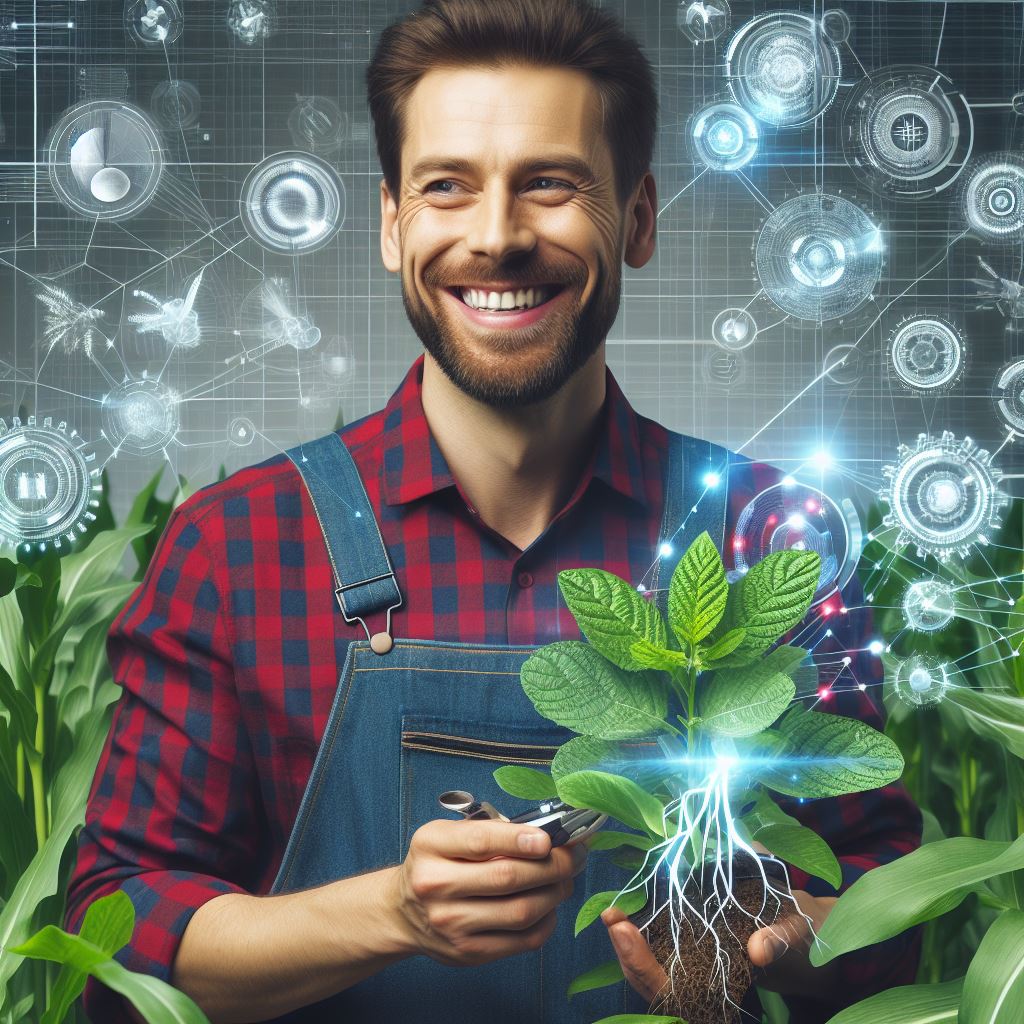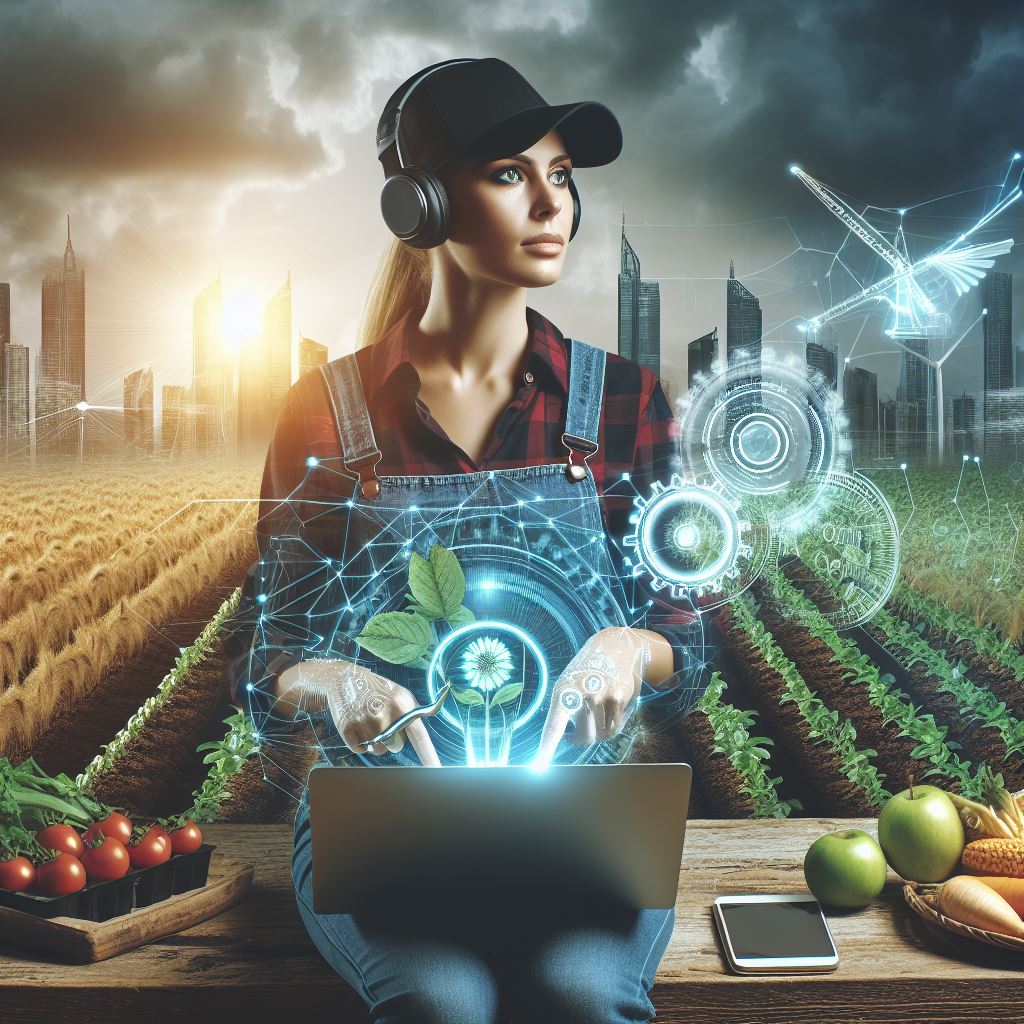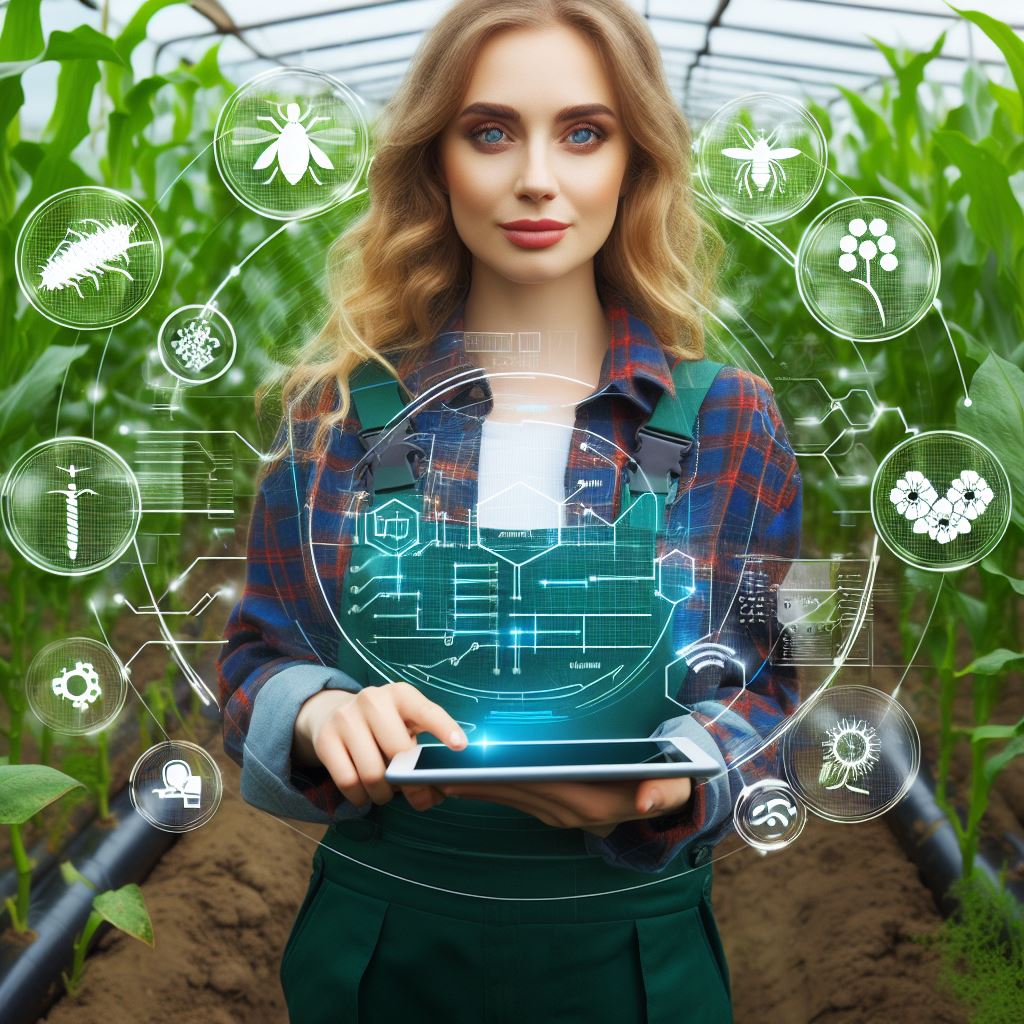Introduction
Why smart farming and precision tech in agriculture are becoming important
Smart farming and precision technology in agriculture are becoming increasingly important due to various reasons.
This blog post will provide a brief overview of why these advancements are necessary in modern farming practices.
With the global population projected to reach 9.7 billion by 2050, it is crucial to find innovative solutions to feed the growing populace.
Smart farming and precision technology offer the potential to maximize crop production while minimizing resource usage.
This blog section will explore the benefits of implementing smart farming techniques such as remote sensing, IoT devices, and data analytics.
By utilizing these technologies, farmers can monitor soil conditions, weather patterns, and crop health in real-time.
Additionally, precision agriculture tools allow farmers to optimize the use of fertilizers, pesticides, and water resources.
Through targeted application, wastage is minimized, resulting in cost savings and reduced environmental impact.
Furthermore, smart farming practices enable farmers to predict crop yields, manage pests and diseases, and make informed decisions to enhance productivity.
By utilizing data-driven insights, farmers can optimize planting schedules, irrigation systems, and harvest timings.
Overall, this blog post aims to highlight the significance of smart farming and precision technology in modern agriculture.
It will delve into the various aspects and solutions that can transform traditional farming practices into sustainable and efficient methods.
By embracing these advancements, farmers can ensure food security, environmental preservation, and economic viability for future generations.
Smart Farming: Precision Tech in Agriculture
Smart farming, also known as precision agriculture, refers to the use of advanced technologies in agriculture to enhance productivity and sustainability.
The primary purpose of smart farming is to optimize the use of resources, increase efficiency, and minimize environmental impacts.
This blog section explores the definition, benefits, and examples of precision technologies used in smart farming.
Definition of smart farming and its main purpose
Smart farming, or precision agriculture, is the implementation of various technologies to manage agricultural systems more efficiently and sustainably.
Its main purpose is to utilize data-driven decision-making to maximize productivity while minimizing resource usage and negative environmental impacts.
Benefits of smart farming in terms of efficiency, cost-effectiveness, and sustainability
- Enhanced Efficiency: Smart farming technologies enable farmers to monitor and manage their crops, livestock, and agricultural processes more effectively. Real-time data collection and analysis allow for precise timing of activities, such as irrigation, fertilization, and pest control. This results in improved efficiency and optimized resource utilization.
- Cost-Effectiveness: By using precision technologies, farmers can reduce operational costs significantly. For example, by precisely applying fertilizers and pesticides only where needed, they can minimize input usage and save money. The automation of tasks also decreases labor expenses, as fewer workers are required for monitoring and controlling operations.
- Environmental Sustainability: Smart farming promotes sustainable agricultural practices by reducing the environmental impact of farming activities. By applying the right amount of inputs at the right time and place, it minimizes the risk of overuse, which can lead to soil degradation and water pollution. Additionally, by optimizing irrigation systems, smart farming helps conserve water resources, a vital aspect of sustainable agriculture.
Examples of precision technologies used in smart farming
- Internet of Things (IoT): IoT devices, such as sensors and actuators, are used to collect data on soil moisture, temperature, humidity, and other environmental factors. This real-time information helps farmers make well-informed decisions regarding irrigation, fertilization, and disease control.
- Remote Sensing: Using satellites, drones, or aircraft, remote sensing allows for the monitoring of crop health, growth patterns, and nutrient deficiencies. This technology provides valuable insights into the condition of plants, enabling timely interventions and preventing yield losses.
- GPS and GIS: Global Positioning System (GPS) and Geographic Information System (GIS) technologies enable farmers to precisely map their fields, track machinery movements, and create digital records. This data helps in planning and implementing targeted interventions, avoiding overlaps, and reducing waste.
- Robotic Automation: Robots equipped with AI and machine learning capabilities can perform labor-intensive tasks autonomously. Robotic automation allows for precise seeding, weeding, spraying, and harvesting operations, reducing reliance on manual labor and increasing operational efficiency.
In fact, smart farming, or precision agriculture, is revolutionizing the agricultural industry.
Utilizing advanced technologies, such as IoT, remote sensing, GPS, GIS, and robotic automation, smart farming offers several benefits.
It enhances efficiency, reduces costs, and promotes sustainability by optimizing resource usage.
As smart farming continues to evolve, it holds the key to addressing the challenges of ensuring food security while minimizing environmental impacts.
Advancements in Precision Tech for Agriculture
Smart farming, also known as precision agriculture, is revolutionizing the way we cultivate crops and manage livestock.
With the help of cutting-edge technologies, farmers can make informed decisions, optimize resource usage, and maximize yields.
In this section, we will explore three key advancements in precision tech for agriculture.
Remote Sensing Technologies: Drones, Satellites, and their Applications
Remote sensing technologies, such as drones and satellites, have transformed the way farmers monitor crops, soil, and weather conditions.
Drones equipped with high-resolution cameras and sensors can capture real-time images and data, allowing farmers to analyze plant health, identify nutrient deficiencies, and assess irrigation needs.
Satellites provide a broader perspective, helping farmers monitor large areas, track weather patterns, and predict potential risks to crops.
By utilizing remote sensing technologies, farmers can identify specific areas of their fields that require immediate attention, thus optimizing resource allocation and improving overall crop health.
This targeted approach reduces the need for excessive pesticide and fertilizer use, leading to more sustainable farming practices.
Internet of Things (IoT): Sensors, Automation, and Data Analytics
The Internet of Things (IoT) has paved the way for interconnected smart devices that can collect and transmit data for various agricultural applications.
Sensors installed in fields, irrigation systems, and livestock facilities provide real-time data on soil moisture, temperature, humidity, and animal behavior.
With the help of IoT, farmers can implement smart irrigation systems that adjust watering based on soil moisture levels, weather forecasts, and crop requirements.
This saves water and prevents over or under-irrigation, resulting in healthier plants and reduced water wastage.
Livestock monitoring devices equipped with IoT sensors can track animal health, detect diseases early on, and optimize feeding regimes for better productivity.
Data analytics plays a crucial role in leveraging the vast amount of information collected by IoT devices.
Farmers can analyze this data to identify patterns, predict crop yields, and make efficient decisions regarding resource allocation, planting schedules, and pest management.
Transform Your Agribusiness
Unlock your farm's potential with expert advice tailored to your needs. Get actionable steps that drive real results.
Get StartedArtificial Intelligence (AI) and Machine Learning: Optimizing Decision-Making Processes
Artificial Intelligence (AI) and Machine Learning (ML) algorithms are transforming the agriculture industry by providing intelligent solutions to complex problems.
By analyzing historical and real-time data, AI can predict crop yields, optimize planting methods, and prevent disease outbreaks.
AI-powered algorithms can detect diseases and pests at an early stage, enabling farmers to take immediate action to protect their crops.
Through image recognition and sensor data analysis, AI systems can identify specific diseases or nutrient deficiencies and recommend targeted interventions.
Additionally, AI can enhance decision-making processes by considering various factors, such as weather forecasts, market demand, and cost analysis.
This allows farmers to make informed choices regarding crop selection, pricing strategies, and resource allocation, ultimately improving profitability and sustainability.
In short, advancements in precision tech for agriculture have significantly transformed the way farmers manage their crops and livestock.
Remote sensing technologies, IoT, AI, and machine learning have revolutionized monitoring, irrigation, disease detection, and decision-making processes.
As these technologies continue to evolve, the future of smart farming looks promising, bringing greater efficiency, sustainability, and productivity to the agricultural sector.
Read: Drip Irrigation: Saving Water in Crop Fields
Impacts of smart farming in agriculture
Smart farming has revolutionized the agriculture industry, bringing significant impacts on productivity, efficiency, and sustainability.
Let’s explore some of the key impacts in more detail.
Increased productivity and yield through optimized resource allocation
One of the primary advantages of smart farming is its ability to optimize resource allocation.
By leveraging technologies like remote sensing, satellite imagery, and Internet of Things (IoT) devices, farmers can monitor various factors such as soil moisture levels, nutrient deficiencies, and pest infestations in real-time.
This data-driven approach enables precise and targeted application of resources such as water, fertilizers, and pesticides, ultimately leading to increased productivity and higher crop yields.
Reduction in input usage, resulting in environmental benefits and cost savings
Smart farming minimizes input wastage by applying resources only where and when they are truly needed.
Through advanced monitoring systems, farmers can closely monitor crop conditions, identify specific areas or plants that require intervention, and apply inputs accordingly.
This targeted approach not only reduces the environmental impacts of excessive input usage, such as water pollution and soil degradation but also helps farmers save money on expensive inputs, resulting in overall cost savings.
Enhanced crop quality and reduced post-harvest losses through improved monitoring and disease detection
Smart farming technologies provide continuous monitoring and early detection of crop diseases, pests, or other stress factors.
Sensors and imaging devices can detect subtle changes in plant physiology, allowing farmers to take immediate action.
By identifying and addressing potential issues promptly, smart farming helps maintain crop health, resulting in improved crop quality.
Additionally, early disease detection and intervention can significantly reduce post-harvest losses, ensuring a higher yield reaches the market.
Transforming traditional farming practices into more sustainable and economically viable operation
Smart farming enables farmers to embrace sustainable practices while making their operations economically viable.
Precision irrigation systems, for example, help optimize water usage by delivering the right amount of water to plants based on their specific needs.
Integrated pest management techniques involve monitoring pest populations and employing targeted control measures, reducing reliance on chemical pesticides.
These practices not only protect the environment and human health but also contribute to long-term economic sustainability by reducing input costs and increasing overall efficiency.
In general, smart farming has brought about several positive impacts in the field of agriculture.
From increasing productivity and yield through optimized resource allocation to reducing input usage and improving crop quality, this technology-driven approach is transforming traditional farming practices into more sustainable and economically viable operations.
As the world faces growing concerns about food security and environmental challenges, smart farming emerges as a crucial solution for ensuring efficient, sustainable, and resilient agricultural systems.
Read: Effective Weed Control in Crop Cultivation

Challenges and Considerations
In the world of smart farming, there are several challenges and considerations that need to be addressed.
From initial setup costs to privacy concerns, farmers face various barriers to adopting and effectively utilizing these technologies.
Initial setup costs and technology adoption barriers for farmers
One of the primary challenges farmers encounter when considering smart farming is the high initial setup costs.
Smart farming technologies, such as sensors, drones, and automation systems, require a significant investment upfront.
Additionally, many farmers may face technology adoption barriers due to limited resources or lack of technical expertise.
They need assistance in understanding and implementing these advanced technologies successfully.
The need for reliable internet connectivity and infrastructure in rural areas
Reliable internet connectivity and infrastructure are crucial for the success of smart farming.
However, many rural areas have inadequate network coverage or slow internet speeds, posing a significant challenge.
In order to fully benefit from smart farming technologies, farmers need a strong and stable internet connection.
Governments and service providers must work together to improve rural connectivity and infrastructure.
Privacy and data security concerns
The collection and use of data in smart farming raise concerns about privacy and security.
Farmers store and analyze sensitive information, such as crop yields and livestock data, which need protection.
It is crucial to establish robust data security measures, including encryption and secure storage systems.
Farmers must also have control over their data and be aware of how it is being used to ensure privacy.
Training and education for farmers to effectively utilize smart farming technologies
To maximize the benefits of smart farming, farmers need proper training and education.
They must acquire the skills to operate and manage these technologies effectively.
Training programs should be provided to farmers, focusing on the use of smart farming tools, data analysis, and troubleshooting.
This will empower them to make informed decisions and optimize their farming operations.
In review, while smart farming offers immense potential and benefits, there are several challenges and considerations that must be addressed.
The high initial setup costs, limited internet connectivity, privacy concerns, and the need for education and training are all factors that can hinder the widespread adoption of these technologies.
However, with proper support and investment, these challenges can be overcome.
By collaborating with governments, service providers, and agricultural organizations, farmers can successfully embrace smart farming and transform their agricultural practices for a more sustainable and efficient future.
Read: Soil pH and Its Impact on Crop Growth
Showcase Your Farming Business
Publish your professional farming services profile on our blog for a one-time fee of $200 and reach a dedicated audience of farmers and agribusiness owners.
Publish Your ProfileSuccess stories and case studies
Smart farming has revolutionized the agricultural industry, transforming traditional farming methods into technologically advanced practices.
Let’s explore some real-world examples and success stories that demonstrate the significant impact of smart farming.
Real-world examples where smart farming has made a significant impact
- Precision irrigation in California: The use of precision technology in irrigation systems has allowed California farmers to optimize water usage, resulting in substantial water savings. This practice has led to increased crop yields and improved water resource management.
- Smart pest control in South Australia: Through the implementation of sensors and remote monitoring, farmers in South Australia have successfully tackled pest infestations. This technology detects pest activity and triggers targeted interventions, minimizing pesticide use and reducing crop damage.
- Automated harvesting in the Netherlands: Dutch farmers have adopted automated harvesting techniques, where robots equipped with computer vision technology can identify and pick ripe crops. This has significantly increased efficiency and productivity, minimizing labor costs and ensuring timely harvests.
- Data-driven livestock management in New Zealand: Livestock farmers in New Zealand have leveraged smart farming technologies to monitor animal health and behavior. Sensors attached to the animals collect real-time data, allowing farmers to track individual performance, optimize feeding regimes, and detect early signs of diseases.
The outcomes and benefits experienced by farmers and agricultural communities
- Increased productivity and profitability: Smart farming practices have improved crop yields, reduced losses due to pests and diseases, and optimized resource utilization. This has resulted in higher profits for farmers, enhancing their livelihoods and economic stability within agricultural communities.
- Resource efficiency and sustainability: Precision technologies enable farmers to use resources such as water, fertilizers, and pesticides more efficiently. This not only reduces production costs but also promotes environmentally friendly farming practices, minimizing the impact on the ecosystem and ensuring long-term sustainability.
- Improved decision-making and risk management: Real-time data collection and analysis allow farmers to make informed decisions and implement proactive measures. By monitoring weather conditions, soil moisture levels, and crop health, farmers can optimize planting schedules, manage irrigation effectively, and mitigate market risks.
- Enhanced quality and safety: Smart farming techniques ensure better-quality produce by enabling timely interventions against pests, diseases, and nutrient deficiencies. Additionally, traceability systems using IoT devices provide consumers with transparent information, assuring them of safe and responsibly produced food.
- Empowering small-scale farmers: Smart farming levels the playing field by providing small-scale farmers access to advanced agricultural technologies. This allows them to compete with larger operations, increase their productivity, and contribute to the overall food supply chain.
- Promoting rural development and job opportunities: The adoption of smart farming practices can stimulate rural economies, as it requires skilled technicians and creates jobs in the technology and agricultural sectors. This fosters the growth of vibrant, sustainable rural communities.
In a nutshell, success stories and case studies highlight the transformative power of smart farming in agriculture.
From precision irrigation to automated harvesting, these real-world examples demonstrate the significant impact on productivity, resource efficiency, decision-making, and rural development.
Ultimately, smart farming not only benefits farmers but also contributes to a more sustainable and resilient agricultural sector.
Read: Cotton Cultivation: Best Practices and Tips
Future Outlook
Predictions for the future of smart farming and precision tech in agriculture
- In the near future, smart farming and precision tech will become mainstream practices in agriculture.
- Advancements in AI and machine learning will enable farmers to make more informed decisions about their crops.
- The integration of Internet of Things (IoT) devices will provide real-time data on soil conditions, weather patterns, and plant health.
- Robotic farming systems will become more advanced, performing tasks such as planting, harvesting, and fertilizing with precision and efficiency.
- Drones equipped with sensors and cameras will be utilized for crop monitoring, disease detection, and spraying pesticides.
- Predictive analytics will help farmers anticipate market demands, optimize resource allocation, and reduce waste.
- Collaborative platforms and data sharing will empower farmers to learn from each other’s experiences and improve overall productivity.
Potential innovations and advancements that could further revolutionize the industry
- Gene editing technologies like CRISPR-Cas9 hold immense potential for creating crops with desirable traits such as disease resistance and higher yields.
- Nanotechnology applications could enhance the efficiency of fertilizers and pesticides, minimizing environmental impact.
- Blockchain technology could be utilized to create transparent supply chains, ensuring the traceability and safety of agricultural products.
- Augmented reality (AR) and virtual reality (VR) could be used for training purposes, allowing farmers to simulate scenarios and learn new techniques.
- Biotechnology advancements may lead to the development of genetically modified organisms (GMOs) that can thrive in diverse environments.
- Integration of renewable energy sources like solar panels and wind turbines in farming operations can reduce dependency on fossil fuels.
- The use of big data and analytics will continue to improve, enabling farmers to make data-driven decisions and optimize their operations.
Importance of continuous research and development in this field
- Continuous research and development are crucial to stay ahead of emerging challenges and seize new opportunities in agricultural technology.
- The field of smart farming is rapidly evolving, and farmers must have access to the latest advancements to remain competitive.
- Research can help streamline existing technologies, making them more affordable and accessible to farmers of all scales.
- Innovations in precision tech and smart farming can contribute to sustainable agriculture practices, reducing resource wastage and environmental impact.
- Collaboration between researchers, farmers, agri-tech companies, and government bodies is essential to drive innovation in the field.
- Continuous research ensures that new technologies are tailored to the specific needs and challenges faced by farmers in different regions.
- Funding and support for research and development in smart farming can lead to breakthroughs that address food security and global agricultural challenges.
In summary, the future of smart farming and precision tech in agriculture is promising.
Predictions suggest that these practices will become integral to the industry, driven by advancements such as AI, IoT, and robotics.
Potential innovations such as gene editing, nanotechnology, and blockchain hold immense possibilities.
Continuous research and development are vital to harness these advancements, improve existing technologies, and ensure sustainable agriculture for the future.
Conclusion
In this blog post, we discussed the key points of smart farming and precision technology.
We encourage farmers to embrace these technologies to enhance their agricultural practices.
Adapting precision tech in agriculture has the potential to bring numerous benefits, but it also comes with some challenges.
Overall, the use of precision technology in agriculture can lead to increased efficiency, reduced waste, and improved yields.
By adopting smart farming techniques, farmers can optimize their resources and reduce environmental impact.
Though initial costs may be high, the long-term benefits of precision tech are undeniable.
It is essential for farmers to stay updated with the latest advancements and collaborate with experts to maximize the potential of these technologies.
Embracing precision tech can revolutionize farming practices and contribute to the sustainable future of agriculture.
Let’s take a step towards smart farming, and together, we can shape a better tomorrow for agriculture.




